Loudoun Heights
Introduction
Text-to-speech Audio
Harpers Ferry National Historical Park includes several hundred acres of land on Loudoun Heights. In addition to a history of private landownership, Loudoun Heights was used to support the Federal Armory at Harpers Ferry. During the Civil War Loudoun Heights was occupied by both Union and Confederate troops, and evidence of those occupations remains visible on the property. After the war, Loudoun Heights saw both agricultural and tourist development and was connected to transportation with the ferry and the Shenandoah Bridge crossing to Harpers Ferry. The Appalachian Trail cuts through a portion of the Loudoun Heights tract.
Images
"Harper's Ferry, West Virginia. View of Loudoun Heights. (Also called: Dismounted Bridge across Armstrong Run)," taken between 1862 and 1865.
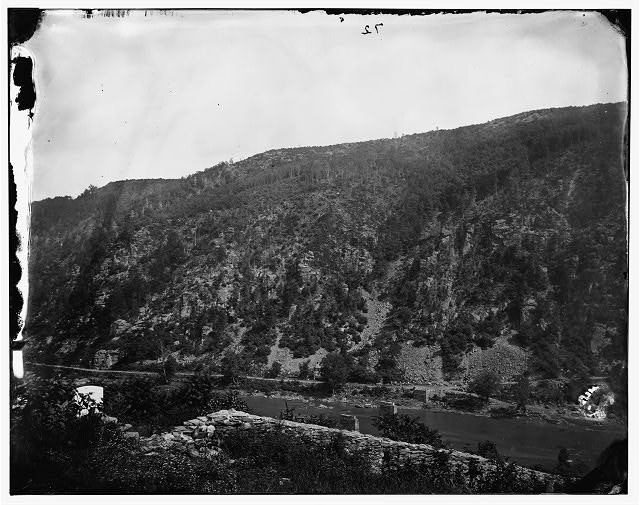
"Harper's Ferry, West Virginia. View of Loudon [i.e. Loudoun] Heights," taken between 1861 and 1865.

"Fairfax Leases on Loudoun Heights, 1786."
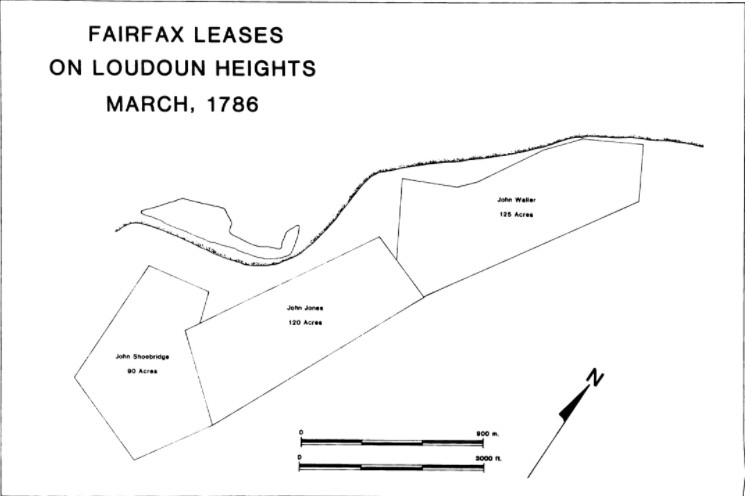
Loudoun Heights, c. 1825
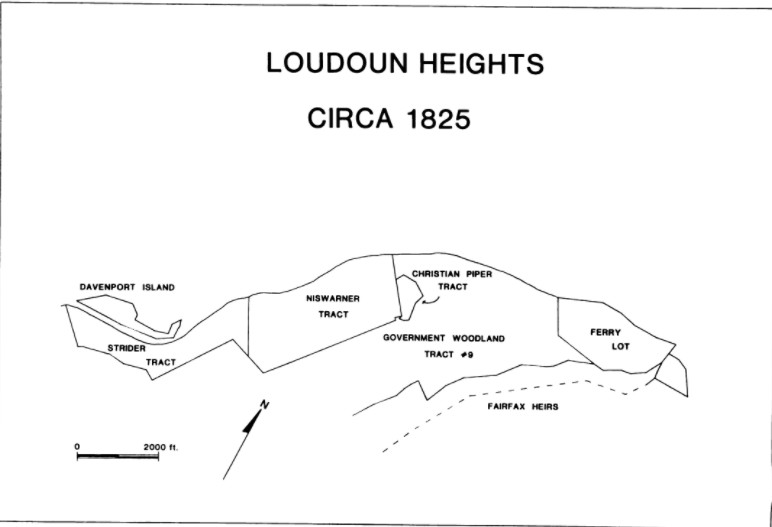
Loudoun Heights properties, 1852

Map of Loudoun Heights properties, October 1862
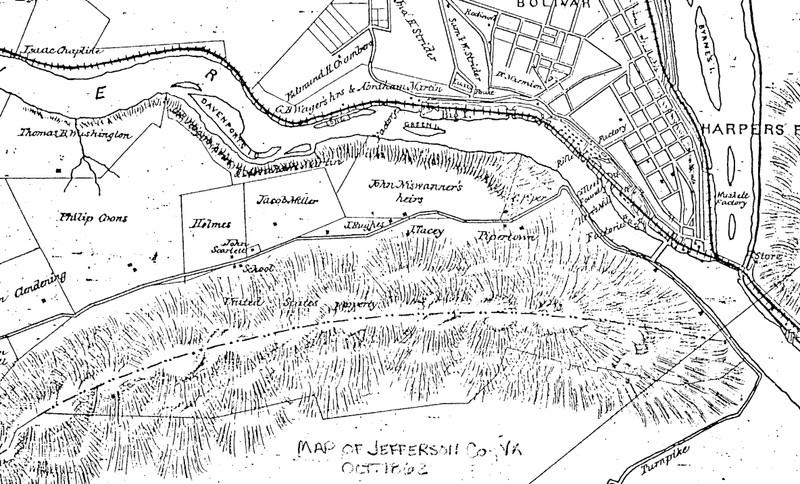
Structures along Loudoun Heights, c. 1863. Detail of: "Military map showing the topographical features of the country adjacent to Harper's Ferry Va. : including Maryland, Loudoun, and Bolivar Heights, and portions of South and Short Mountains, with the positions of the defensive works : also the junction of the Potomac & Shenandoah Rivers, and their passage through the Blue Ridge."
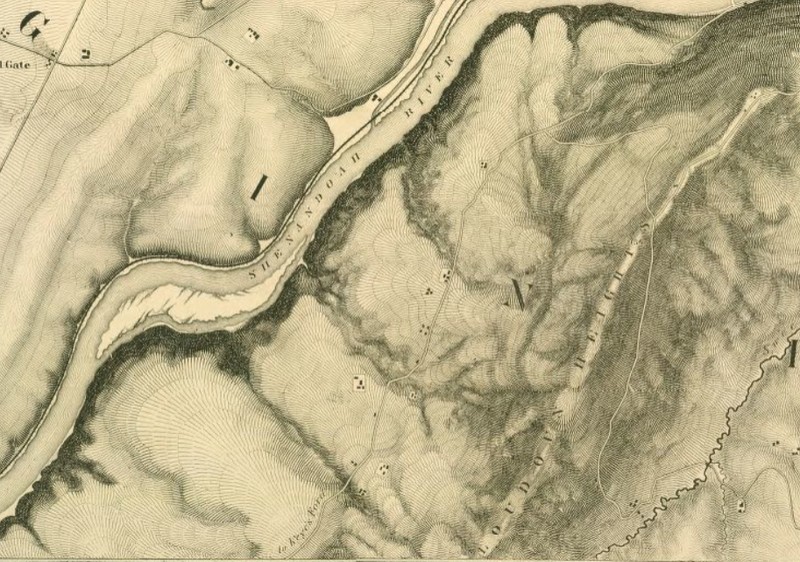
"Part of Union General Nathaniel Bank's encampment on Loudoun Heights, near Harpers Ferry (Frank Leslie's Illustrated News, November 8, 1862)
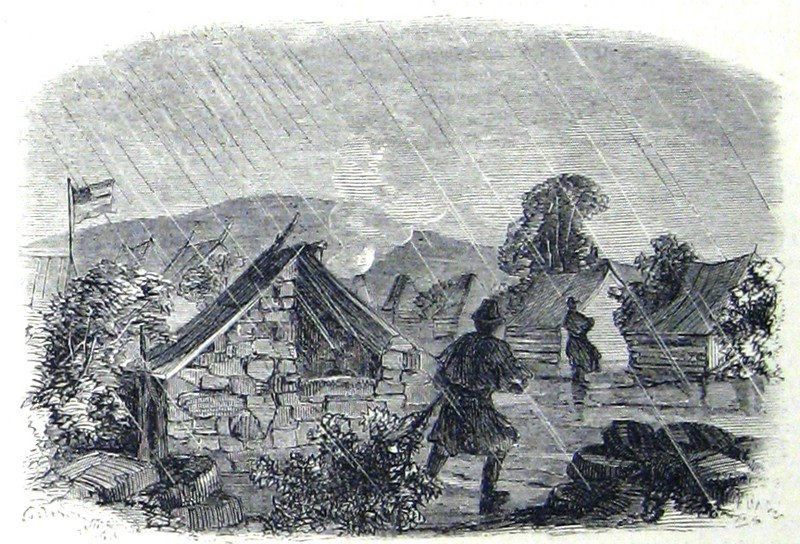
"Union soldiers gather around a campfire on top of Loudoun Heights while a comrade communicates with a signal station on Maryland Heights (Frank Leslie's Illustrated News, November 8, 1862)
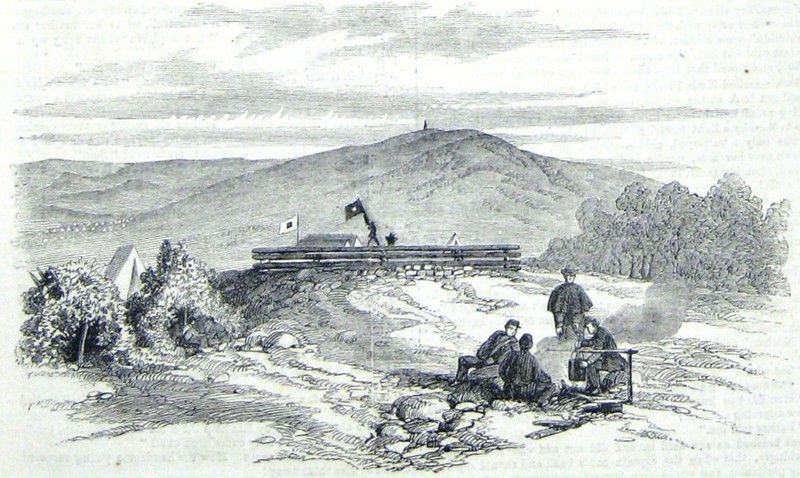
"Union wagoneers drive loads of stones, procured by the labor of Confederate prisoners armed with picks, up Loudoun Heights in an effort to repair the roads (Frank Leslie's Illustrated Newspaper, November 1, 1862)
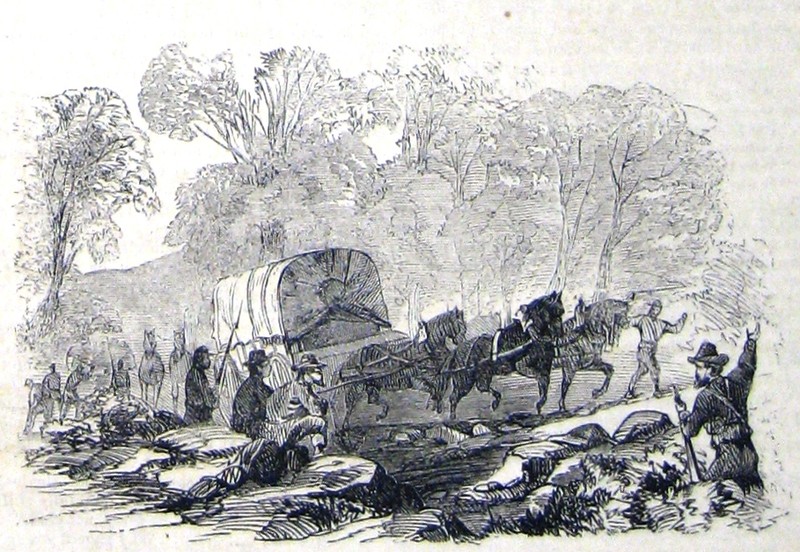
Loudoun Heights properties, 1901
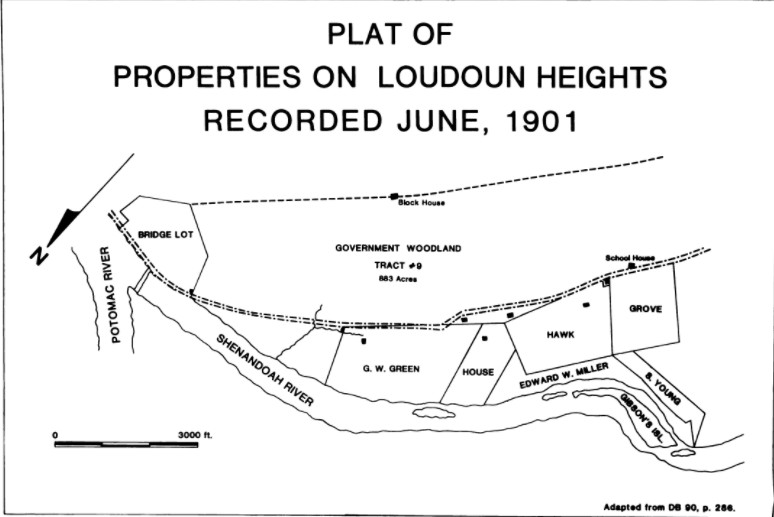
Loudoun Heights properties, 1932
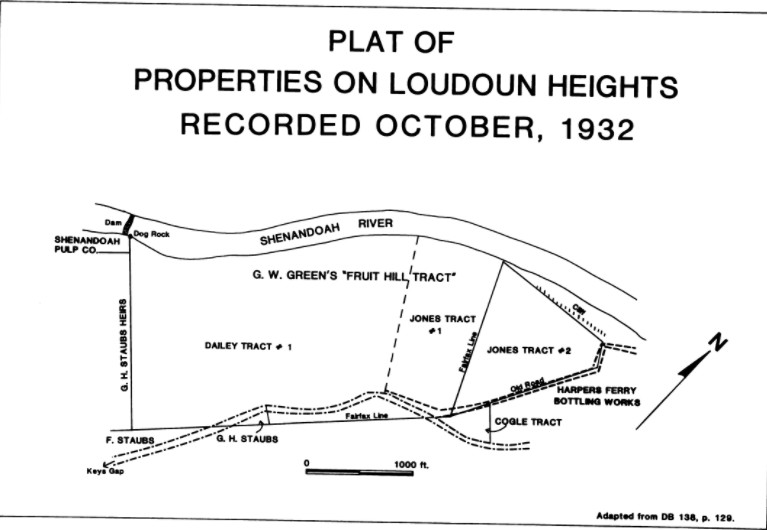
Loudoun Heights properties conveyed to U.S. Government, 1953-1981
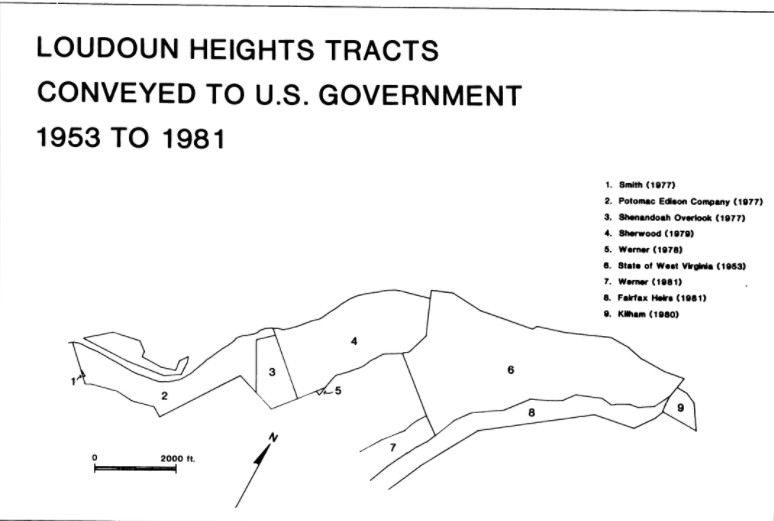
"Loudoun Heights. Site 35' -Loudoun Heights. Blockhouse, south anchor of. Original caption: NHF-2250 LOUDOUN HEIGHTS SITE 35'-LOUDOUN HEIGHTS BLOCKHOUSE, SOUTH ANCHOR OF DEFENSE LINE. PROBABLY HELD OFF MOSBY'S RAIDERS IN JAN 1865. VA-WVA STATE LIVE C.B.KING MAY 1963."
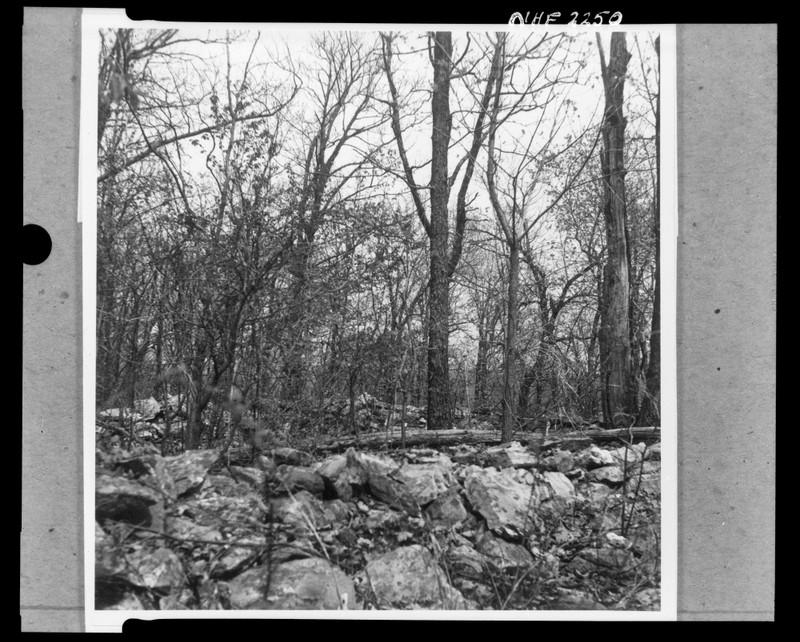
"Fortifications. Loudoun Heights. Handbook. Original caption: NHF 1978, Fortifications, Loudoun Heights, A.L. Sullivan, May 1962."
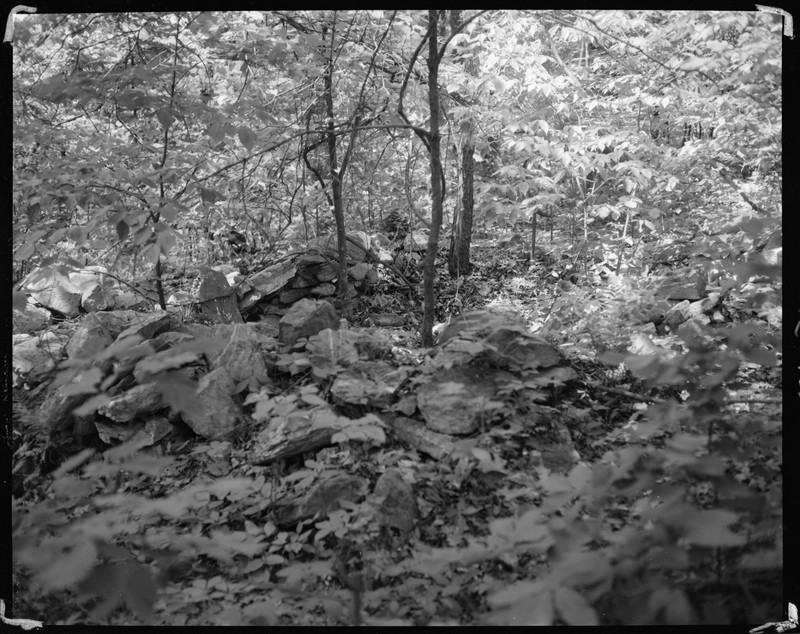
"Fortifications. Loudoun Heights. Handbook. Original caption: NHF 1979, Fortifications, Loudoun Heights, A.L. Sullivan, May 1962."

"Fortifications. Loudoun Heights. Handbook. Original caption: NHF 1981, Fortifications, Loudoun Heights, A.L. Sullivan, May 1962."
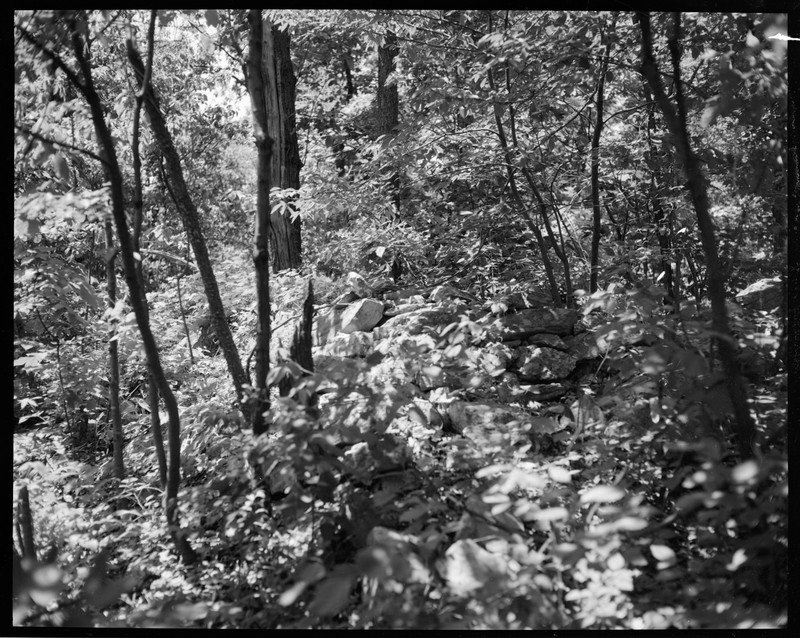
"Fortifications. Loudoun Heights. Handbook. Original caption: NHF 1980, Fortifications, Loudoun Heights, A.L. Sullivan, May 1962."

"Fort Site 29 -Loudoun Heights -See Map 2066, Fort Site 26 - (from West) -See Map, 2066, In same envelope as # 2251. Loudoun Heights. Original caption: NHF-2251 &NHF-2252 FORT SITE 29-LOUDOUN HEIGHTS -SEE MAP 2066, FORT SITE 26 - (FROM WEST) LOUDOUN HEIGHTS -SEE MAP 2066 LOUDOUN HEIGHTS CLYDE B. KING - MGMT ASS'T,HFNM MAY 1963."
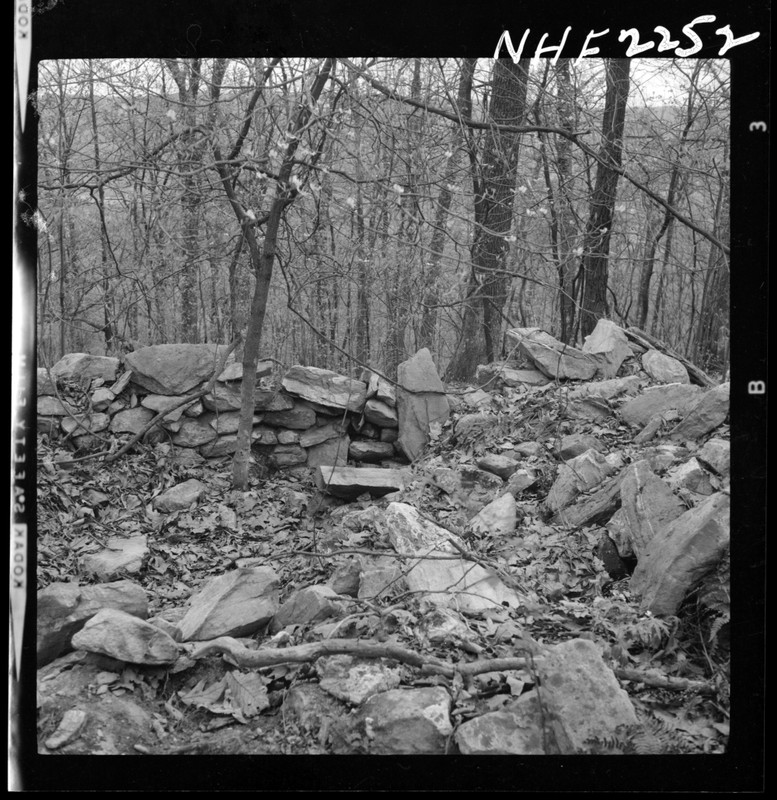
"Fort Site 29 -Loudoun Heights -See Map 2066, Fort Site 26 - (from West) -See Map, 2066, In same envelope as # 2252. Loudoun Heights. Original caption: NHF-2251 &NHF-2252 FORT SITE 29-LOUDOUN HEIGHTS -SEE MAP 2066, FORT SITE 26 - (FROM WEST) LOUDOUN HEIGHTS -SEE MAP 2066 LOUDOUN HEIGHTS CLYDE B. KING - MGMT ASS'T,HFNM MAY 1963."
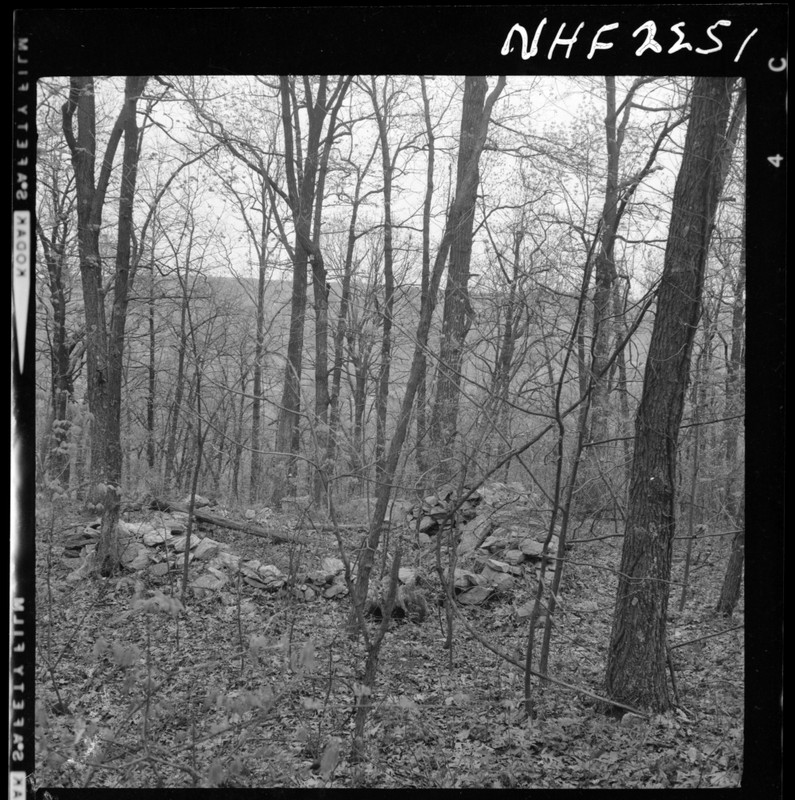
"Old Fort -Loudoun Heights, See map 2066. Original caption: NHF-2249 OLD FORT -LOUDOUN HGTS SEE MAP 2066 VLYDE B. KING APR 1963."
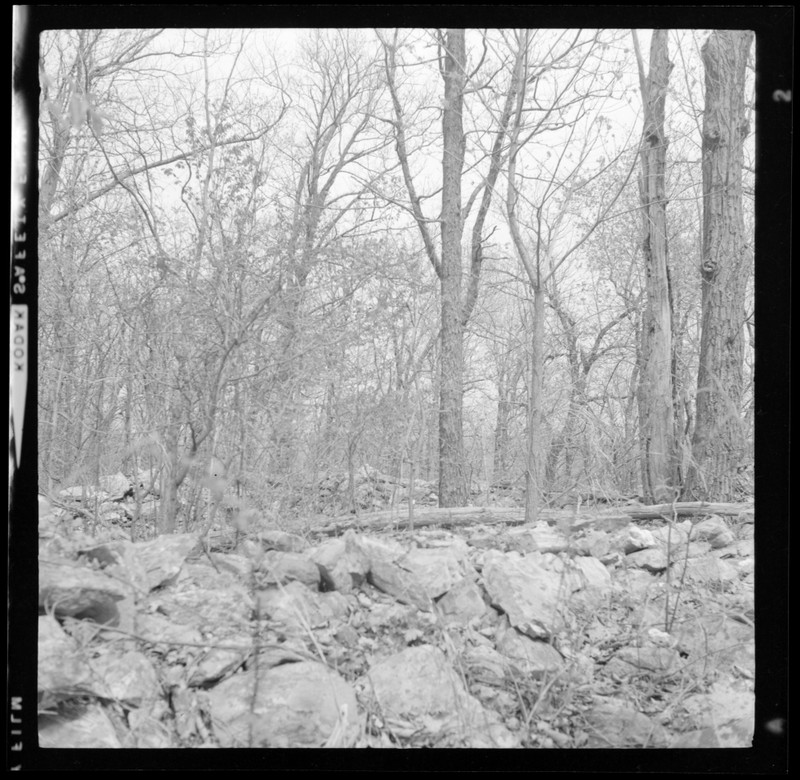
The 1882 Shenandoah Bridge (right) was destroyed in the 1889 flood
.jpg)
The replacement Shenandoah Bridge (foreground), photographed March 18, 1936 in rising flood waters.
.jpg)
Photograph on March 19, 1936 shows the Shenandoah Bridge destroyed by the floodwaters
.jpg)
Sherwood House (Niswarner Tract), c. 1999
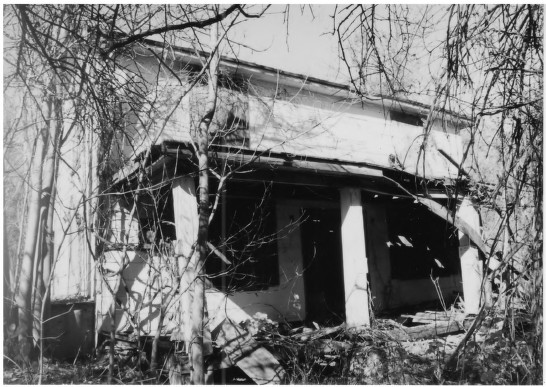
Sherwood House (Niswarner Tract), c. 1999
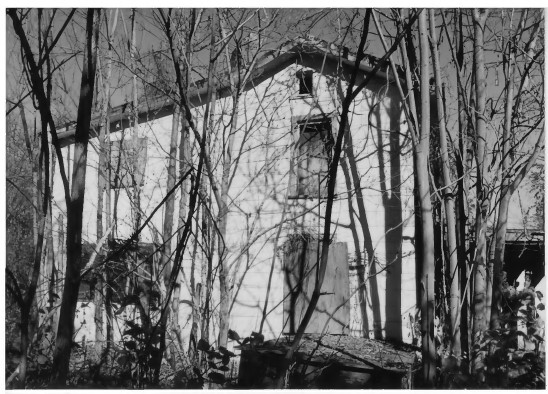
Sherwood House (Niswarner Tract), c. 1999
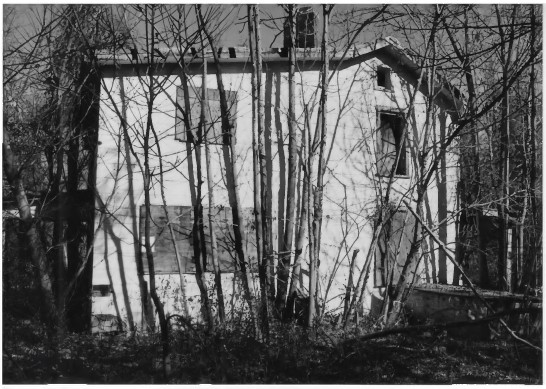
Sherwood House (Niswarner Tract), c. 1999
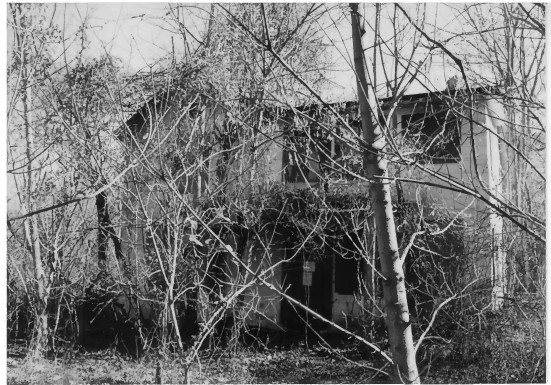
Sherwood House (Niswarner Tract), c. 1999
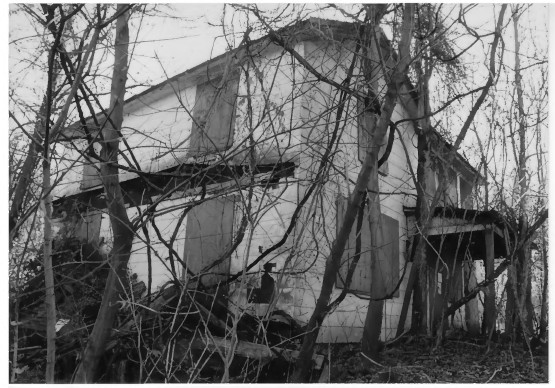
Sherwood House (Niswarner Tract), c. 1999
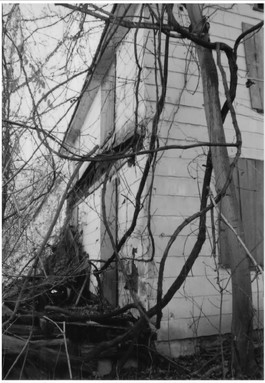
Loudoun Heights section of Harpers Ferry National Historical Park
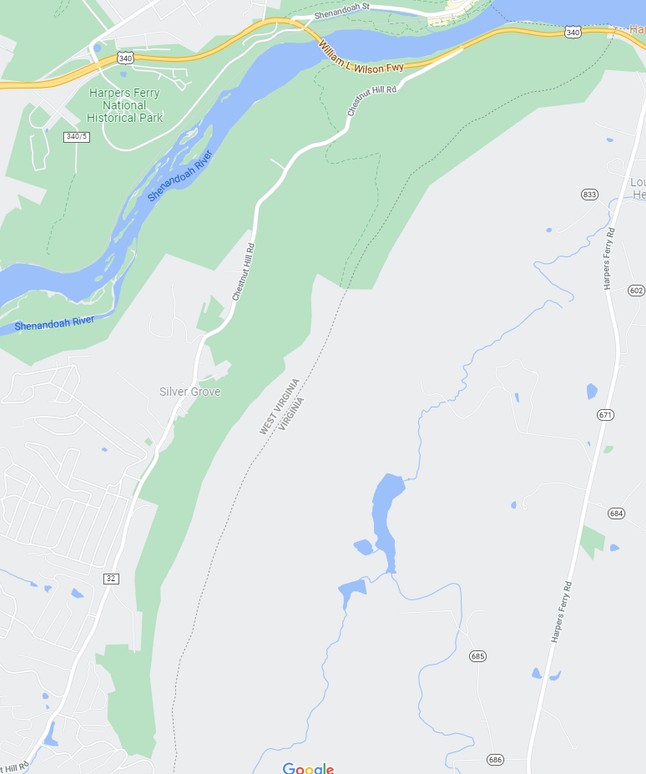
Backstory and Context
Text-to-speech Audio
Loudoun Heights Prior to 1860:
The entire area around Harpers Ferry was originally part of the large tract of land claimed by Lord Fairfax. In the late 1700s Fairfax began leasing out sections of land on Loudoun Heights; in March 1786 Fairfax leased 90 acres to John Shoebridge, 120 acres to John Jones, and 125 acres to John Waller (the Shoebridge and Jones tracts are largely outside NPS boundaries). John Waller’s lease required that he construct a house and barn on the property within two years as well as improve the land by planting 125 apple and 150 peach trees. An additional requirement was that he leave 25 acres of untouched woodland.
The Waller property transferred to the Niswarner family in 1818 when Catharine Niswarner purchased two tracks from Fernando Fairfax for $7,347.50—this was the previous Waller and Jones leased properties split in two tracts of 151 and 142 acres (total 293 acres). Catharine held the title for the 151 acre tract until 1828 when she sold it to her son John for $2400. John and his wife, also named Catharine, had a family of eight children when they lived on the Loudoun Heights property. When John Niswarner died in 1833, the farm was left to Catharine and the children with the intention that it would eventually be divided among his heirs. Over the next few decades Catharine managed the property successfully, bringing it to a higher value that the neighboring farms. The only division of the Niswarner Tract prior to the Civil War was in 1855 when 30 acres were split off to William C. House, who married Catharine Niswarner (John and Catharine’s daughter, third generation Catharine).
In 1822, William Herbert (administering the estate of Ferdinando Fairfax) sold 62.75 acres to John Strider who owned a flour mill and 200 acres on the other side of the Shenandoah River. Strider placed his entire estate in trust to William Lucas and Isaac Fouke in 1835 and after Strider died in 1848 the trustees sold the land on both sides of the river to Gerard B. Wager and Abraham Martin. Martin acquired Wager’s interest in the properties in 1849 and a decade later Martin sold the land to the Shenandoah City Water Power and Manufacturing Company which planned on developing the west bank of the river.
Another tract of 11 acres was sold by William Herbert (administering the estate of Ferdinando Fairfax) to Christian Piper and George Piper in 1822. The Piper Tract remained in that family until at least 1852 after which it was incorporated into the Kirwan and Cogle Tracts. There is no existing record of the transfer of property from the Pipers to Thomas Kirwan, but the later Kirwan Tract consisted of almost the entire Piper Tract. There is evidence that Kirwan was on the property by 1856 (because he was accused of squatting), but there are no records of Kirwan owning the land until 1874.
A third tract along the Shenandoah River was sold by William Herbert in 1822 to John Neer, Jr. Neer sold this tract of 12 acres to Absolan Vancacter in 1826 and Vancacter’s son sold 9 of the acres to Hiram Carney in 1849. The tract was further split in 1854 when 2.5 acres of the riverfront was purchased by James Leakin in 1854.
In addition to privately-owned tracts, the U.S. Government held a large portion of Loudoun Heights. In August 1813 the government purchased timber rights on 1,395 acres to supply wood and charcoal to the Federal Armory at Harpers Ferry. There were also two armory buildings on the Loudoun Heights side of the Shenandoah, describe as such in the 1980 National Register of Historic Places Nomination:
“Armory Dwelling No. 9, a two-story stone house built between 1818 and 1830, was located on the Loudoun bank of the Shenandoah River near the Shenandoah Bridge. During the 1850s it was rented by the Hillsborough and Harpers Ferry Turnpike Company as a toll house. It was in fair condition and vacant at the end of the Civil War. There are no visible remains.”
“Armory Dwelling No. 10, a one-story stone house erected in 1810, was located just east of Armory Dwelling No. 9. Before the Civil War it was rented to an armorer. In 1865 it was in good condition and occupied free of rent by a Mrs. Stipes. There are no visible remains.”
Loudoun Heights in the Civil War:
Harpers Ferry was constantly in the path of the Union and Confederate armies during the Civil War and the three heights around the town proved central in many of the events during those years. Loudoun Heights is about 300 feet shorter than Maryland Heights on the other side of the converging rivers, so it did see less activity compared to its neighbor. The majority of Civil War activity on Loudoun Heights occurred in 1861 and 1862, with mostly picket activity in the remaining years of the war.
The first military fortification of Loudoun Heights came in May 1861 after Colonel Thomas Jackson took command of the Confederate garrison stationed at Harpers Ferry (after the Confederates seized control of the armory town the month prior). Knowing the military importance of the heights around town, he began fortifying all three (Bolivar Heights, Maryland Heights, and Loudoun Heights). For Loudoun Heights the Confederates began construction of three blockhouses in early May and by the end of the month when Brigadier General Joseph E. Johnston took command of the garrison two companies of Confederate Infantry (around 200 men) and possibly some artillery was positioned on the crest of the Heights. Johnston and the garrison left Harpers Ferry on June 14, 1861 and destroyed several structures in the town, but the blockhouses on Loudoun Heights were left intact.
The only contemporary description of the three Confederate blockhouses was recorded by David Hunter Strother, a topographer with Major General Robert Patterson’s Union force who viewed the blockhouses in the summer of 1861: “On the summit we found a cleared space about half a mile long and a hundred yards wide with three block houses located two hundred yards apart. The first was on a rough stone foundation, surmounted by a square double log structure covered with thick plank and pierced for musquetry [sic]. The second was of the same character but not complete and the third was only commenced.” With the Union army reoccupying Harpers Ferry the 12th New York Infantry (companies A, B, C, and E) occupied the blockhouses for a few weeks starting in early August.
In Spring 1862, Harpers Ferry was a central base of supply for Major General Nathaniel Banks’ operations in the Shenandoah Valley against Major General Thomas “Stonewall” Jackson. In late February 1862 Banks secured Harpers Ferry for the Union by sending Colonel John W. Geary of the 28th Pennsylvania to occupy the town. During this operation Geary sent five companies of the 28th PA with two guns from Knap’s Battery to secure Loudoun Heights. The Pennsylvanians occupied the blockhouses for a brief period of time.
After the initial operation to secure Harpers Ferry, Colonel Dixon S. Miles took command of operations there, but he did not fortify any of the heights surrounding the town. At the end of May 1862, Jackson’s force surprised and routed Banks in the Shenandoah Valley and sent the Federal force retreating towards Williamsport. Union leadership in Washington, D.C. panicked and sent Brigadier General Rufus B. Saxton to improve the defenses at Harpers Ferry. Saxton sent two companies of the 1st Maryland Potomac Home Brigade Infantry to secure Loudoun Heights on May 27, but the men encountered Confederate resistance and did not continue advancing up the heights. Soldiers from Jackson’s force could be seen on Loudoun Heights from Harpers Ferry the next day, but the Confederates only remained in that position for a few days before moving back south and did not seriously threaten Harpers Ferry. After Jackson’s men left, soldiers from the 1st Maryland Potomac Home Brigade returned to Loudoun Heights on June 1 to burn the Confederate blockhouses.
“Stonewall” Jackson’s corps returned to Harpers Ferry in September 1862 during the Antietam Campaign. As part of General Robert E. Lee’s plan to invade into Maryland, he needed to secure Harpers Ferry for the Confederates. To take Harpers Ferry Jackson had 14,000 men move in three columns to take the three heights surrounding the town. Major General Lafayette McLaws with 7,000 men took Maryland Heights, Jackson’s wing headed towards Bolivar Heights, and Major General John G. Walker had 2,000 men to take Loudoun Heights. Just as in the spring, Union commander Dixon Miles had not fortified Loudoun Heights. Walker’s force was able to occupy the heights by the afternoon of September 13 with troops from the 27th North Carolina and 30th Virginia who established a signal station and dragged artillery pieces onto position over Harpers Ferry.
Walker’s force was in position and ready by the afternoon of September 14, but Jackson needed to wait for McLaws to be in position on Maryland Heights before acting. Walker became impatient with waiting and paraded soldiers from the 46th and 48th North Carolina in view of Harpers Ferry. When Union guns took the bait and fired on his troops, Walker responded by firing his artillery towards Camp Hill. Later the other two positions on Bolivar and Maryland Heights joined into the artillery barrage, but the firing on September 14th did not force the Union force to surrender. With pressure growing on General Robert E. Lee’s main force, Jackson needed Harpers Ferry to surrender quickly so he could join the rest of the army. In preparation for September 15 Jackson had troops under Major General A. P. Hill reposition to flank the Union position on Bolivar Heights and had his chief of artillery, Stapleton Crutchfield, move 10 guns across the Shenandoah River to the Niswarner Tract. The batteries of Dement, Brown, Latimer, and Garber took positions on Loudoun Heights to support the infantry advance. On the morning of the 15th Jackson’s plan worked and the Union force surrendered Harpers Ferry. That night Walker’s troops left Loudoun Heights to join the rest of Jackson’s corps to join Lee at Sharpsburg, MD.
The last major Civil War activity on Loudoun Heights occurred in fall of 1862 when Major General George McClellan and the Army of the Potomac reoccupied Harpers Ferry after the Battle of Antietam. To hold Loudoun Heights McClellan sent the 2nd Division of the XII Corps (at about 2400 men this was one of the smallest divisions in the Army of the Potomac) to occupy the heights for about five weeks beginning September 23. The division commander, Brigadier General John W. Geary, reported that he moved his camp to an orchard on October 10, and this was likely an orchard on the Niswarner property. The division remained on Loudoun Heights until October 28 when they moved to a new position on the east side of the valley, and then on October 30 they transferred across the river to Bolivar Heights. At the end of October a brigade under Brigadier General Thomas S. Kane (consisting of the 20th CT, 123rd NY, 124th PA, and 125th PA) briefly occupied the area around the Niswarner farm, but they ultimately moved closer to the eastern base of the heights to set up their winter encampment. This was the last substantial occupation of Loudoun Heights during the war. In 1863-1865 there was only scattered picket activity on Loudoun Heights.
After the events of 1862, McClellan wanted to reinforce the heights around Harpers Ferry with permanent fortifications. He ordered Cyrus B. Comstock to survey Maryland and Loudoun Heights and lay out a plan for a series of fortifications to protect the town. Between September 26 and October 17, Comstock worked on his plan for entrenched camps on both sets of heights with stone and log blockhouses or redoubts. His plan would have cost $30,000 to implement and the War Department never approved the plan, despite McClellan’s urging. Instead, the War Department recommended temporary field fortification, but there is no definite evidence that these were constructed.
The Loudoun Heights Civil War encampments are the best preserved within the National Park boundaries. Because they were utilized only in 1862 and then abandoned there was little change, unlike on Maryland Heights which saw a lot more activity over the entire war. In addition, the three 1861 Confederate blockhouses are still extant.
Loudoun Heights After the Civil War:
Catharine Niswarner likely died before or around 1870 because during that year the family petitioned the chancery court to divide the property among the family, as John Niswarner had requested before his 1833 death. The court denied the request to divide the land, and instead recommended that the family sell the property and divide the money. Between 1871 and 1877 the Niswarner family attempted to sell the tract four times, with several buyers defaulting on their payments. Finally Florence Kirwin purchased the land in 1877 for $924 and then conveyed it to George W. Green two year later. When Green took over the Niswarner property he renamed it “Fruit Hill Farm,” which indicates that it was still being used as an active orchard. For the first decade, Green did not maintain the farm well, but in 1889 he decided to construct a hotel on the property. This was probably due to the increase in tourist traffic through Harpers Ferry in the late 1800s as well as the construction of the Shenandoah Bridge to facilitate visitors to the Loudoun Heights side of the river. Green’s Mountain House reportedly had 56 rooms and was valued at $5100 in 1890. It is possible that the hotel expanded further in 1896 to accommodate more rooms. Unfortunately for Green, the hotel did not financially succeed and it was listed for sale in 1898. Green struggled to sell the property privately, so the property went up for public sale and Charles E. Roach purchased it in 1899. A fire in April 1902 destroyed the hotel and devalued the property. Afterwards, Roach sold 21.5 acres to Joseph M. Jones in 1909 and then 100 acres to William F. Daily in 1910.
For the Kirwan Tract, the first official record of ownership by Thomas Kirwan was in 1874. Kirwan died a few years later, and several people sued his estate over debts. As a result, Florence Kirwan purchased the property (then 20 acres for $200) in 1887. The very next year the land was sold to Elizabeth Hawk and then Hawk sold it to Scott E. Hersey in 1893. When Hersey defaulted on the mortgage, the property was resold to Joseph Jones in 1906 (this was in addition to the land he purchased from the Niswarner Tract in 1909). The remainder of the original Piper Tract, about 2.1 acres, has very few records prior to 1912 except for evidence that a Susan Piper had been squatting there in the 1850s. George W. and Charlotte Piper sold the tract, labeled the “Aunt Susie Piper land,” in 1912 to John Cogle. Cogle only held the land briefly, selling it to David Howell in 1913.
In 1912 David J. Howell purchased the 100-acre tract from William Daily (the former Niswarner & Green’s Mountain House property), then added the 21.5 acres bought from Joseph Jones, and then the Kirwan and Cogle Tracts. All of these separate tracts were combined under the “Fruit Hill Farm” property. C. A. Plummer purchased the farm from Howell in 1922, but defaulted on the sale, after which the farm was sold to Charles Carroll Brooks. George T. and Mittie R. Staubs purchased the property in 1932, Mary E. Marquette owned it between 1937 and 1955, and then four members of the Sherwood family bought it. The Sherwoods owned the land until 1979 when they conveyed the tract to the U.S. Government.
The House tract, consisting of the 30 acres from the Niswarner tract split off to William House (husband of Catharine Niswarner House) in 1855, remained in the family until 1882 when the House heirs sold the property to Elizabeth Hawk. In 1886, Hawk sold the land to Jonathan Cogle and then Mary Cogle sold the land to Charles Roach in 1983 (who also later purchased the Niswarner tract). In 1907 Ellen Staubs purchased two tracts of land from Charles Roach, including the House Tract. Eight years later the Staubs placed their entire property into a deed of trust, under which is remained until 1935 when it was purchased by Margaret Shirley. The House Tract passed through several more owners before it became part of the Shenandoah Overlook, Inc. in 1973 and then was purchased by the U.S. Government in 1977. Two acres of the original House tract were separated, this tract was the two acres along the river front, and sold by Mary Cogle to Thomas Green in 1891. This small tract was purchased by the Shenandoah Pulp Company in 1892, then transferred to the Harpers Ferry Paper Company in 1924. Like their other nearby property, discussed below, this was transferred to the Potomac Light and Power Company in 1944.
Another nearby tract, known as the “Bottling Works Tract,” was owned by Margaret Kirwan in the 1880s although there is little record of the Kirwans owning the land prior to this date. Kirwan sold the 2-acre property to James Manfield in 1886. Manfield sold the property to John Hankey in 1891, who then sold the land to James C. McGraw in 1895. His father, James McGraw had opened a brewery in Harpers Ferry in 1885 and established a bottling business in 1888. James C. McGraw inherited his father’s business in 1893 and expanded it. The purchase in 1895 of the “Bottling Works Tract” was to supply water to the brewery from the spring located on this tract. There were apparently property disputes over this tract due to the value of the spring, but McGraw defended his ownership. Unfortunately, McGraw declared bankruptcy in 1897 after a costly fire at the brewery and the Loudoun Heights property was placed in trust to James M. Mason (the bankruptcy lawyer) along with McGraw’s other properties. Mason sold the land to the Leder-Weidman Brewing Co. in 1906. In the 1920s the tract was owned by Harry F. Longbrake and James B. Grimes and the spring supplied water to the town of Harpers Ferry. The property remained in those two families until 1953 when they sold the land to the State of West Virginia.
The 60 acres purchased by the Shenandoah City Water Power and Manufacturing Company were never developed as the company had planned. The Civil War halted any plans for development and after the war was over the owners decided to sell the property to Edward W. Miler in 1868. Miller placed the acreage in trust to Henry M. Tschudy in 1880 and Tschudy held it for twenty years before selling it to George R. Bready. The land ended up back in the hands of those wishing to develop Harpers Ferry in the 1920s when the 60 acres was purchased by the Jefferson Power Company. Two years later the property was sold to the Harpers Ferry Paper Company and in 1944 it was transferred to the Potomac Light and Power Company.
Davenport Island is also within the Loudoun Heights section of National Park Service Property. The governor of Virginia granted the island, around 19 acres of land, to Braxton Davenport in August 1816. Davenport died in 1866 and his daughter, Francis W. Gibson, inherited the property. Gibson sold the island to George R. Bready in June 1908. Like Bready’s 60-acre tract, the Jefferson Power Company acquired the land in 1922 and then sold it to the Harpers Ferry Paper Company in 1924. The island was sold to the Potomac Light and Power Company in 1944 and the U.S. government purchased Davenport Island in 1977.
The tract owned by James Leakin prior to the Civil War was sold to Isaac Fouke in the 1880s. The Fouke heirs sold the land to the Harpers Ferry and Loudoun Bridge Company in 1905. In 1942, when Virginia was constructing U.S. Route 340, the Bridge Company sold this tract to the state as part of the right-of-way land. Excess land from the right-of-way was exchanged for property held by Russell M. and Mildred H. Sexton; the Sextons received 9.16 acres which they sold to Dixie D. Kilham in 1964. The remaining property from the original Carney tract, about 6.5 acres, was largely abandoned until the end of the 1800s when it was claimed by John P. Derry. Derry’s estate sold the property to G. W. Kernodle in 1911 and the Kernodle family sold it to Dixie D. Kilham in 1974, reuniting the two parts of the tract. Kilham conveyed 11.34 acres to the U.S. government in 1980, this was land that lay within the Appalachian Trail system.
Prior to the Civil War the U.S. Government owned 1,396 acres on the south side of the Shenandoah River. This was purchased on August 20, 1813 and was used largely as a woodlot for the purposes of the Federal Armory. In 1869, the Federal Government sold all of its holdings in Harpers Ferry, including the Loudoun Heights woodlot. David King initially purchased the timber rights to the lot, but he defaulted on the payments causing the rights to be resold in 1880. At that point the large tract was divided—George Green purchased the timber rights for the West Virginia property (883 acres) and Edward Tearney, Patrick Higgins, and Thomas Kirwan purchased the rights for the Loudoun County, Virginia property (512 acres). The soil and timber rights for the former government woodlot remained separated for about two decades. The soil rights for the 883 West Virginia acres were purchased by James M. Mason in 1877, Mason sold them to Daniel B. Lucas in 1881, and then Charles and Louis Becker acquired the soil rights in 1889. George Green held the timber rights until 1882 when he sold them to James Danby and James Clark. Clark and Danby sold the timber rights to Charles and Louis Becker in 1888, reuniting the soil and timber rights for the property. The Becker family continued to own the tract until 1953 when they sold it to the Conservation Commission of West Virginia.
Shenandoah Ferry Lot:
In the early 1800s Ferdinando Fairfax, heir to the large Fairfax estate of land in western Virginia, operated a ferry across to Harpers Ferry. In 1810 Fairfax leased the ferry operation to Job C. Harding under the stipulation that Harding build a boat and ferry house on the property. Eight years later, Fairfax sold the Ferry Lot, 68 acres of land, to the U.S. Government along with the ferry rights across the Shenandoah River. This was at the point that the Federal Government was setting up the armory at Harpers Ferry and needed to transport men and supplies across the river at a more affordable rate. The government paid $5000 for the property and leased the ferry operation out to individuals; Job Harding continued to operate the ferry until his death and then other ferryman leased the position after him. Like the other federal properties at Harpers Ferry, the U.S. government owned the lot through the Civil War but sold it in 1869. Initially, John W. Neer and Company purchased the Ferry Lot, but he defaulted on his payments and the government resold the tract to Joshua Cavalier in 1880. Cavalier purchased the land for the Harpers Ferry Bridge Company who constructed the Shenandoah Bridge in 1882 (this was the first bridge across the Shenandoah since the Shenandoah Wagon Bridge downstream at Bridge Street was destroyed early in the Civil War). The record flood of 1889 destroyed the Shenandoah Bridge and in 1892 the Harpers Ferry and Loudoun Bridge Company purchased the Ferry Lot. The Shenandoah Bridge was reconstructed and served vehicle traffic until it was destroyed in the 1936 flood. The bridge was not rebuilt and in 1952 the Harpers Ferry and Loudoun Bridge Company sold the property to the Conservation Committee of West Virginia.
Loudoun Heights under the National Park Service:
As of 1980, the National Park Service held 276.80 acres on Loudoun Heights. In 1986 about 3,000 feet of the Appalachian Trail was rerouted away from the crest of the heights, to a plateau on the north side of the heights, in order to protect the Civil War resources present on Loudoun Heights. In addition, in 1988 there was a two-year study done on the landscape and resources on Loudoun Heights.
Sources
Gilbert, David T. A Walker's Guide to Harpers Ferry, West Virginia. Eighth Edition. Harpers Ferry Historical Association.
Hull-Walski, Deborah A., and Frank L. Walski. “There’s Trouble a-Brewin’: The Brewing and Bottling Industries at Harpers Ferry, West Virginia.” Historical Archaeology 28, 4 [An Archaeology of Harpers Ferry’s Commercial and Residential District] (1994): 106-121.
“National Register of Historic Places Inventory—Nomination Form: Harpers Ferry National Historical Park.” Accessed September 17, 2021. https://wvculture.org/wp-content/uploads/2021/03/Harpers-ferry-national-historical-park.pdf/
“National Register of Historic Places Registration Form: Niswarner Tract.” Accessed September 17, 2021. https://wvculture.org/wp-content/uploads/2021/03/Niswarner-tract.pdf.
Winter, Susan E., and Dennis E. Frye. Loudoun Heights: Archeological & Historical Resources Study. Harpers Ferry National Historical Park, 1992. Accessed through HathiTrust, September 17, 2021. https://catalog.hathitrust.org/Record/002857893.
Harper's Ferry, West Virginia. View of Loudoun Heights. Also called: Dismounted Bridge across Armstrong Run. United States, None. [Between 1862 and 1865] Photograph. https://www.loc.gov/item/2018672232/. Accessed September 29, 2021. https://www.loc.gov/resource/cwpb.03685/.
Harper's Ferry, West Virginia. View of Loudon i.e. Loudoun Heights. United States Harper's Ferry West Virginia, None. [Photographed between 1861 and 1865, printed between 1880 and 1889] Photograph. https://www.loc.gov/item/2014646043/. Accessed September 29, 2021. https://www.loc.gov/item/2014646043/.
Winter, Susan E., and Dennis E. Frye. Loudoun Heights: Archeological & Historical Resources Study. Harpers Ferry National Historical Park, 1992. Accessed through HathiTrust, September 17, 2021. https://catalog.hathitrust.org/Record/002857893.
Winter, Susan E., and Dennis E. Frye. Loudoun Heights: Archeological & Historical Resources Study. Harpers Ferry National Historical Park, 1992. Accessed through HathiTrust, September 17, 2021. https://catalog.hathitrust.org/Record/002857893.
Winter, Susan E., and Dennis E. Frye. Loudoun Heights: Archeological & Historical Resources Study. Harpers Ferry National Historical Park, 1992. Accessed through HathiTrust, September 17, 2021. https://catalog.hathitrust.org/Record/002857893.
“National Register of Historic Places Registration Form: Niswarner Tract.” Accessed September 17, 2021. https://wvculture.org/wp-content/uploads/2021/03/Niswarner-tract.pdf.
Weyss, J. E, N Michler, United States Army Of The Potomac. Engineer Dept, and United States Army. Corps Of Engineers. Military map showing the topographical features of the country adjacent to Harper's Ferry Va.: including Maryland, Loudoun, and Bolivar Heights, and portions of South and Short Mountains, with the positions of the defensive works: also the junction of the Potomac & Shenandoah Rivers, and their passage through the Blue Ridge. [Washington, D.C.?: Engineer Dept., Army of the Potomac, ?, 1863] Map. https://www.loc.gov/item/lva0000037/. Accessed September 29, 2021. https://www.loc.gov/resource/glva01.lva00037/?r=0.109,0.659,0.815,0.396,0.
"After Antietam." Crossroads of War: Maryland and the Border in the Civil War. Accessed September 29, 2021. https://www.crossroadsofwar.org/galleries/after-antietam/.
"After Antietam." Crossroads of War: Maryland and the Border in the Civil War. Accessed September 29, 2021. https://www.crossroadsofwar.org/galleries/after-antietam/.
"After Antietam." Crossroads of War: Maryland and the Border in the Civil War. Accessed September 29, 2021. https://www.crossroadsofwar.org/galleries/after-antietam/.
Winter, Susan E., and Dennis E. Frye. Loudoun Heights: Archeological & Historical Resources Study. Harpers Ferry National Historical Park, 1992. Accessed through HathiTrust, September 17, 2021. https://catalog.hathitrust.org/Record/002857893.
Winter, Susan E., and Dennis E. Frye. Loudoun Heights: Archeological & Historical Resources Study. Harpers Ferry National Historical Park, 1992. Accessed through HathiTrust, September 17, 2021. https://catalog.hathitrust.org/Record/002857893.
Winter, Susan E., and Dennis E. Frye. Loudoun Heights: Archeological & Historical Resources Study. Harpers Ferry National Historical Park, 1992. Accessed through HathiTrust, September 17, 2021. https://catalog.hathitrust.org/Record/002857893.
"Loudoun Heights." Open Parks Network. HAFE-1359_NHF2250. Accessed September 29, 2021. https://openparksnetwork.org/single-item-view/?oid=OPN_NS:E1FEE601219E850CB5B80F33100D7C17&b=https%3A%2F%2Fopenparksnetwork.org%2Fsearch-results%2F%3Fk%3Dloudoun%26opn_refine_control%3Djump%26xi%3D1%26xm%3D20%26sf%3D%26facet-contributinginstitution%5B%5D%3DHarpers%2520Ferry%2520National%2520Historical%2520Park.
"Handook, Harpers Ferry, West Virginia." Open Parks Network. HAFE-1359_NHF1978. Accessed September 29, 2021. https://openparksnetwork.org/single-item-view/?oid=OPN_NS:E252798F0B74B2DF30FFCD2508A9814D&b=https%3A%2F%2Fopenparksnetwork.org%2Fsearch-results%2F%3Fk%3Dloudoun%26opn_refine_control%3Djump%26xi%3D1%26xm%3D20%26sf%3D%26facet-contributinginstitution%5B%5D%3DHarpers%2520Ferry%2520National%2520Historical%2520Park.
"Handook, Harpers Ferry, West Virginia." Open Parks Network. HAFE-1359_NHF1979. Accessed September 29, 2021. https://openparksnetwork.org/single-item-view/?oid=OPN_NS:55ED5AB041AB4BFDE82926FE29280072&b=https%3A%2F%2Fopenparksnetwork.org%2Fsearch-results%2F%3Fk%3Dloudoun%26opn_refine_control%3Djump%26xi%3D1%26xm%3D20%26sf%3D%26facet-contributinginstitution%5B%5D%3DHarpers%2520Ferry%2520National%2520Historical%2520Park.
"Handook, Harpers Ferry, West Virginia." Open Parks Network. HAFE-1359_NHF1981. Accessed September 29, 2021. https://openparksnetwork.org/single-item-view/?oid=OPN_NS:35E9102960244E695286F82C579D57BC&b=https%3A%2F%2Fopenparksnetwork.org%2Fsearch-results%2F%3Fk%3Dloudoun%26opn_refine_control%3Djump%26xi%3D1%26xm%3D20%26sf%3D%26facet-contributinginstitution%5B%5D%3DHarpers%2520Ferry%2520National%2520Historical%2520Park.
"Handook, Harpers Ferry, West Virginia." Open Parks Network. HAFE-1359_NHF1980. Accessed September 29, 2021. https://openparksnetwork.org/single-item-view/?oid=OPN_NS:8ABC60C5953271B48387115B8238C630&b=https%3A%2F%2Fopenparksnetwork.org%2Fsearch-results%2F%3Fk%3Dloudoun%26opn_refine_control%3Djump%26xi%3D1%26xm%3D20%26sf%3D%26facet-contributinginstitution%5B%5D%3DHarpers%2520Ferry%2520National%2520Historical%2520Park.
"Map, Harpers Ferry, West Virginia." Open Parks Network. HAFE-1359_NHF2252. Accessed September 29, 2021. https://openparksnetwork.org/single-item-view/?oid=OPN_NS:128C695ACB2A90298438FBEBD75F5837&b=https%3A%2F%2Fopenparksnetwork.org%2Fsearch-results%2F%3Fk%3Dloudoun%26opn_refine_control%3Djump%26xi%3D21%26xm%3D20%26sf%3D%26facet-contributinginstitution%5B%5D%3DHarpers%2520Ferry%2520National%2520Historical%2520Park.
"Map, Harpers Ferry, West Virginia." Open Parks Network. HAFE-1359_NHF2251. Accessed September 29, 2021. https://openparksnetwork.org/single-item-view/?oid=OPN_NS:36B0A1923A724E98C6E4719A3358D338&b=https%3A%2F%2Fopenparksnetwork.org%2Fsearch-results%2F%3Fk%3Dloudoun%26opn_refine_control%3Djump%26xi%3D21%26xm%3D20%26sf%3D%26facet-contributinginstitution%5B%5D%3DHarpers%2520Ferry%2520National%2520Historical%2520Park.
"Map, Harpers Ferry, West Virginia." Open Parks Network. HAFE-1359_NHF2249_002. Accessed September 29, 2021. https://openparksnetwork.org/single-item-view/?oid=OPN_NS:1212F056AD7A9635B90198C1C5BE96C9&b=https%3A%2F%2Fopenparksnetwork.org%2Fsearch-results%2F%3Fk%3Dloudoun%26opn_refine_control%3Djump%26xi%3D21%26xm%3D20%26sf%3D%26facet-contributinginstitution%5B%5D%3DHarpers%2520Ferry%2520National%2520Historical%2520Park.
"Floods at Harpers Ferry." Harpers Ferry Explorer. Dave Gilbert Graphic Design. Accessed September 29, 2021. http://www.dgilbert53.net/?page_id=832.
"Floods at Harpers Ferry." Harpers Ferry Explorer. Dave Gilbert Graphic Design. Accessed September 29, 2021. http://www.dgilbert53.net/?page_id=832.
"Floods at Harpers Ferry." Harpers Ferry Explorer. Dave Gilbert Graphic Design. Accessed September 29, 2021. http://www.dgilbert53.net/?page_id=832.
National Register of Historic Places Documentation--Harpers Ferry National Historical Park. Accessed October 14, 2021. http://npshistory.com/publications/hafe/nr-harpers-ferry-nhp.pdf.
National Register of Historic Places Documentation--Harpers Ferry National Historical Park. Accessed October 14, 2021. http://npshistory.com/publications/hafe/nr-harpers-ferry-nhp.pdf.
National Register of Historic Places Documentation--Harpers Ferry National Historical Park. Accessed October 14, 2021. http://npshistory.com/publications/hafe/nr-harpers-ferry-nhp.pdf.
National Register of Historic Places Documentation--Harpers Ferry National Historical Park. Accessed October 14, 2021. http://npshistory.com/publications/hafe/nr-harpers-ferry-nhp.pdf.
National Register of Historic Places Documentation--Harpers Ferry National Historical Park. Accessed October 14, 2021. http://npshistory.com/publications/hafe/nr-harpers-ferry-nhp.pdf.
National Register of Historic Places Documentation--Harpers Ferry National Historical Park. Accessed October 14, 2021. http://npshistory.com/publications/hafe/nr-harpers-ferry-nhp.pdf.
Google Maps. Accessed September 29, 2021.
